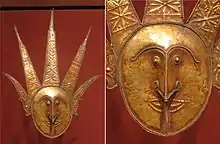Maluku culture
Maluku, a group of islands within the Indonesian archipelago,[1] has a variety of culture and customs expressed in music, tools, languages, dance, and art.[2]

Kalwedo
One of the many cultures is known as Kalwedo.[2] Kalwedo is valid proof of ownership of indigenous peoples in Southwest Maluku (MBD).[2] This ownership is joint ownership of common life.[3] Kalwedo is rooted in the lives of indigenous peoples in the Babar archipelago and MBD.[2] The Kalwedo cultural inheritance is expressed in a language game, customs, and discourse.[3]
Hawear
Hawear is a growing and prevailing culture in the public life of the Kei Islands, passed from one generation to the next.[4] Folklore, folk, and a variety of written documents are among the means by which cultural treasures including Hawear are preserved.[5]
See also
References
| Wikimedia Commons has media related to Culture of the Moluccas. |
- M Adnan Amal, Kepulauan Rempah-rempah : Perjalanan Sejarah Maluku Utara 1250-1950, June 2010.
- Aholiab Watloly, Fransina Matakena, Dominggus Saiya, Frans Dahoklory, 2012 Balai Pelestarian Nilai Budaya Ambon.
- "Budaya Kalwedo di Maluku Barat Daya". Unpatti. Archived from the original on 13 November 2013. Retrieved 2 April 2014.
- Jacobus W.Mosse, Johannes M.S., Telelepta, F.X., Vincent R. Letsoin, Kementerian Pendidikan dan Kebudayaan Balai Pelestarian Budaya Ambon, Hawear di Kepulauan Kei, 2012.
- "Hawear di Kepulauan Kei". Unpatti. Archived from the original on 11 November 2013. Retrieved 2 April 2014.